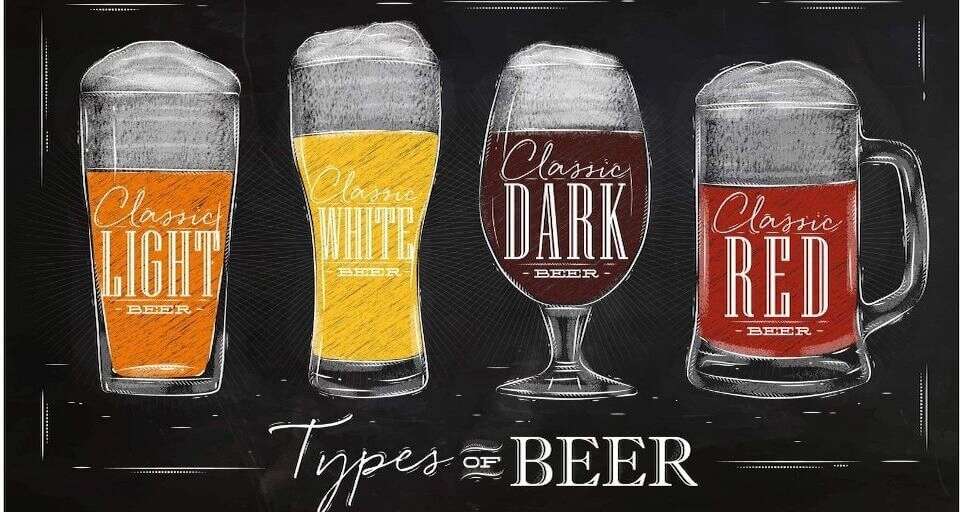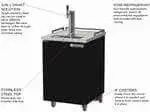
Different Types of Beer
Although the name has Germanic roots, beer, one of the oldest human-created beverages, has been around for at least 7000 years, dating back to ancient Egypt and Mesopotamia. It then spread all across the world, including to Europe, where beer has been brewed for the past 5000 years. After a production boost from the Industrial Revolution, beer has moved from a domestic beverage to a global industry, with billions of gallons sold annually.
Any beer involves three ingredients: grains (e.g., wheat, barley, hops, rice, or oats), water, and yeast. Over time, beer has been generally classified between two different styles, ales and lagers.
Ales and Lagers
These two beers have some key differences. Ales have been around much longer than lagers, with ales hailing back to ancient times and lagers a more recent invention from several hundred years ago. How these two styles of beers are crafted is different.
Ales are fermented for a short period of time, at a warm temperature. On the other hand, lagers (which means “to store” in German) are fermented for longer periods of time, at colder temperatures. How the yeast is used in each type of brew also differs. During the fermentation process, ales require top-fermenting yeasts, meaning that the yeast stay on top of the beer. Lagers need bottom-fermenting yeasts, or yeasts which sink to the bottom.
When it comes to the drinking experience, ales and lagers have two distinct feels and tastes. An ale typically will have a darker colors (a richer golden color to an amber red) and use malted barley as the grain, with a few different varieties such as brown, cream, and pale. In comparison, a lager is usually a lighter both in color and in taste, but also can range in color. Lagers also have more carbonation and have a crisper, smoother finish.
Other Beer Classifications
Since the invention of ales and lagers, there has been further stratification of the different types of beers, including specialty beers and hybrid beers, which can take one part of a fermentation process, such as the cold temperatures of the lager process using an ale yeast—or vice versa.
Beers also differ in a number of ways:
- The regionwhere it is brewed
- The ingredientsused in the brew
- The appearance of the beer (usually the clarity and color)
- The amount of alcoholin the beer
- The flavor profile
With both ales and lagers, the region is one of the primary ways to further classify beers. Most beers are made in the United States or in Europe, although other countries such as Japan and Mexico have their own popular brews. Another way to further stratify beers is by the subcategory under ale or lager.
Types of Ales
- Porter Developed in London, England during the 1700s, this is a hoppy, dark beer made with brown malt.
- Stout A stout beer is a stronger kind of porter which is made with hops, roasted barley or roasted malt.
- Brown This type of ale has a dark amber or brown color. The flavors can vary from sweet to bitter to malty and hoppy.
- Amber/Red A type of pale ale, Amber ales typically come from Australia, France, and North America. They range in color from a light copper to a light brown and are typically brewed with amber malt and sometimes crystal malt to create the amber color.
- Pale A 16th century concoction, pale ales are brewed with pale malts, with varying amounts of hops and a variety of brewing methods. These come in a number of varieties, with India Pale Ale (IPA) one of the most popular.
- Strong Also known as stock ales, old ales, or winter warmers, these ales have a higher alcohol content than pale ales, but not as strong as barley
- wines. The taste is sweet and malty and the color is typically a deep amber.
- Belgian Trappist/Abbey This type of beer is brewed in Trappist monasteries, mostly in Belgian monasteries, but also in Austria, Italy, the Netherlands, and in the United States. Abbey beers are brewed in non-Trappist monasteries or commercial breweries. Trappist beers are brewed with Trappist ale yeast and have a unique taste. They are served in special glasses and come in four different styles: regular, double (duppel), triple (trippel), and quadruple (quadrupel).
- Wheat Beer More wheat than malt is used in wheat beers. The two main types are Weissbier (also known as Weizenbier or Hefeweizen) and Witbie
r. Weissbier, which is typically brewed in Germany, comes in a variety of colors, blends and clarities. Witbier (also known as bière blanche, white beer) is brewed in Belgium or the Netherlands and have a sour taste and are cloudy in appearance due to the yeast which floats in the beer.
Types of Lagers
- Pale LagerA more recent recipe of lager from Germany, from the 1840s, this beer is very light to golden in color and ranging in a hoppy flavor. Pilsners are the most popular kind of pale lagers.
- Bock A strong lager from Germany, this beer can vary in colors, from light copper to brown. Maibock (helles bock or heller bock) is paler and typically consumed during the sprint. Doppelbock (double bock) is stronger, while eisbock stronger still, created from the ice that forms when the beer is frozen. Weizenbock is brewed with wheat in place of barley.
- Dark Lager Lagers were typically dark before the advent of pale lagers and can vary in color, from amber to dark reddish brown. Depending on the brewing method, region, or color, dark lagers have other names: Vienna lager, amber lager, dunkel, schwarzbier, or tmavé.
This ancient beverage has proliferated into hundreds of styles, especially as home brewing grows in popularity. Whether it's a specialty brew in a growler, or a beer from a local brewery or bar, there’s at least one beer style for every beer lover to enjoy.
